Outforia Quicktake: Key Takeaways
- Vultures play a crucial role in maintaining healthy ecosystems as nature’s clean-up crew, feeding on carrion and disposing of dead and decaying animals.
- There are 23 species of vultures worldwide, with 16 Old World vultures native to Europe, Africa, and Asia, and 7 New World vultures native to the Americas.
- Vultures are scavengers, using their keen eyesight and strong stomach acids to locate and digest rotting meat, killing harmful bacteria in the process.
- Many vulture species are endangered or have declining populations due to human activities, such as habitat destruction, poisoning, and hunting. Conservation efforts are underway to protect these vital birds and their role in the ecosystem.
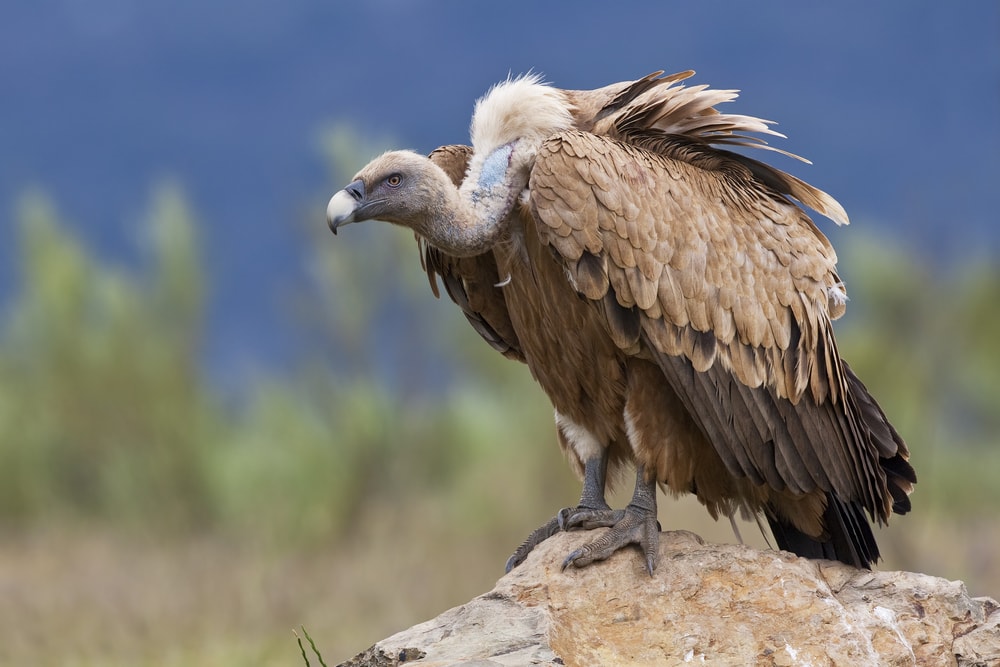
Vultures aren’t the prettiest birds out there. They lack the beauty of songbirds, eagles’ power, and larks’ grace.
Despite this, vultures are one of the most common birds in the world. They also play an essential role in maintaining healthy ecosystems.
Vultures live on every continent except Antarctica and Australia. There are 23 species of vultures. These can be divided into two categories: Old World vultures and New World vultures.
Old world means vultures native to Europe, Africa, and Asia, and New World refers to the Americas. There are 16 species of Old World vultures and 7 species of New World vultures.
Old World vs. New World Vultures
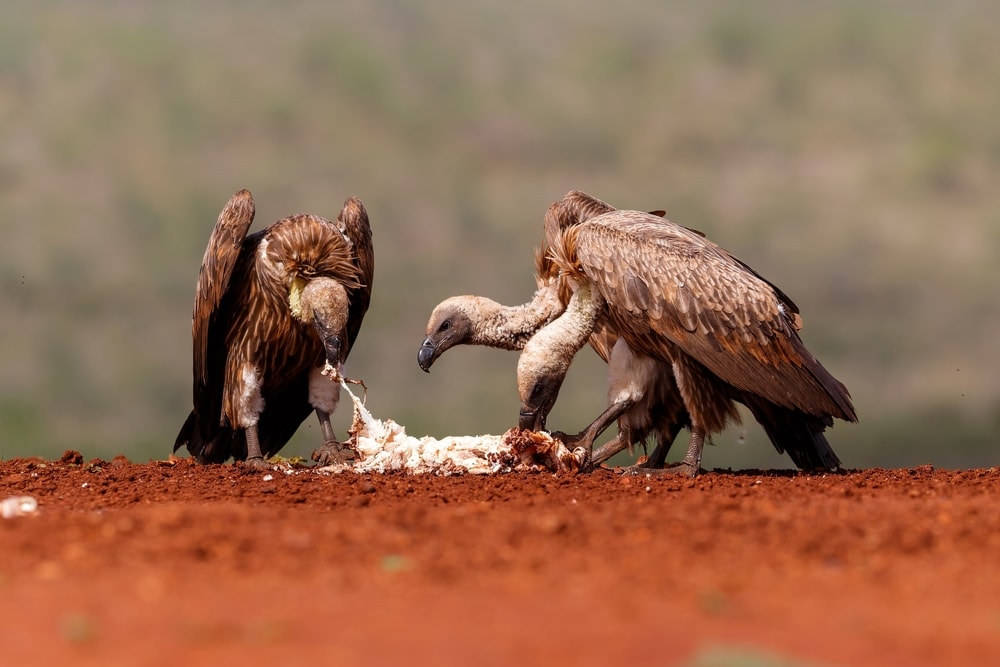
There are many similarities when you compare Old World to New World vultures.
To start, all vultures are scavengers. This means that vultures don’t hunt, pursue, and kill prey for food as hawks or eagles do. Instead, vultures glide high above the land, looking below for carrion to feast on.
Most vultures worldwide have bald, featherless faces. This might make them look haggard or ugly, but it’s actually for sanitation. Because vultures stick their heads in and out of dead animals all day, a featherless head is essential for staying clean. Otherwise, blood and gore would get stuck to a vulture’s face.
Look at it this way: If you somehow got pieces of meat stuck in your hair every time you ate a meal, you’d probably shave your head too!
All vultures also have strong stomach acids, which help them digest rotting meat. In addition, their stomach acid kills off any potentially harmful bacteria in decomposing flesh.
But despite the similarities, there are many differences as well.
For starters, New World vultures are the only vultures to cool themselves by pooping on their legs. This act is known as urohydrosis.
New World vultures also lack a voice box, so they can only hiss or snort. However, Old World vultures have voice boxes so they can vocalize more than their New World counterparts.
Also, New World vultures don’t build nests. Instead, they find suitable locations like a hollow log, dense leaf cover, or abandoned buildings to lay their eggs in.
But the most significant difference between Old World and New World vultures is that they are not closely genetically related. This means New World vultures didn’t evolve from Old World vultures or vice versa. Instead, this is a perfect example of convergent evolution.
Convergent evolution is a phenomenon in which different species evolve with similar features across space and time.
For example, in the case of vultures, they both evolved to fill similar ecological niches, so they evolved similar features as well.
Now, let’s look at the different types of vultures, starting with Old World vultures.
You May Also Like: 22 Types Of Hawks, Legendary Birds Of Prey : Pictures + Facts
Old World Vultures
White-headed Vulture (Trigonoceps occipitalis)
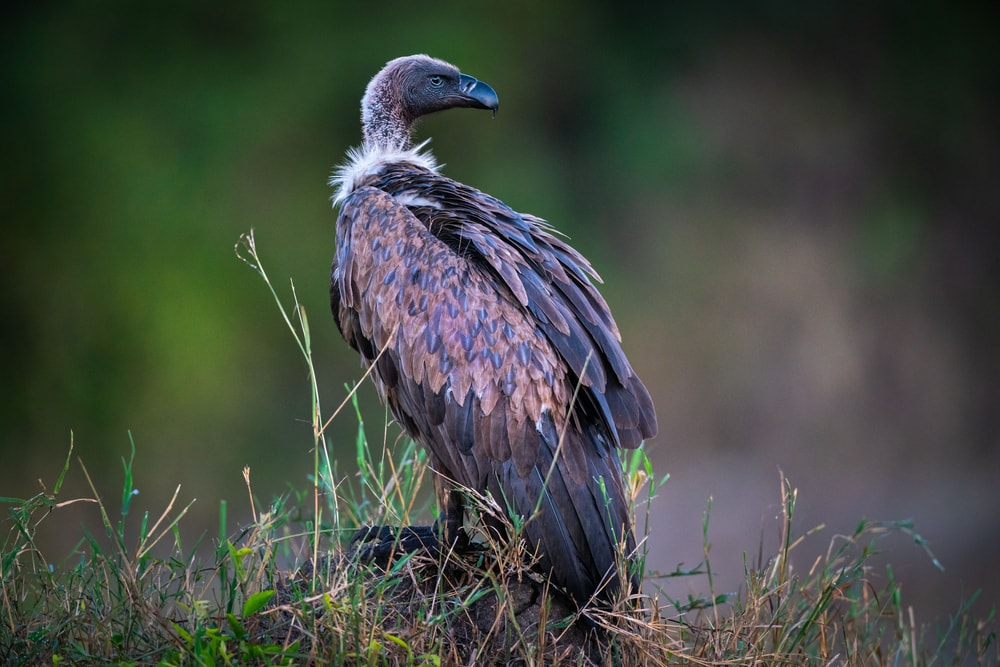
Native to Africa, the white-headed vulture stands over 2 feet (61 cm) tall and has a wingspan upwards of 6 feet (1.8 m).
As the name suggests, these vultures have bald, pale white heads with orangish beaks. They have black and white feathers, the white feathers mostly on their underside.
Unfortunately, because of pesticide poisoning, white-headed vulture populations have rapidly declined in recent years. Vultures have strong stomach acids but not strong enough to break down pesticide compounds.
White-headed vultures were upped from a “vulnerable” species to a “critically endangered” species in 2015. Some biologists believe that 97% of white-headed vulture populations have been lost in recent decades.
White-headed vultures prefer nesting in African baobab trees. In fact, some researchers see a pattern between the range of the baobab tree and the white-headed vultures. Where there are baobab trees, there are likely white-headed vultures nearby too.
Also, white-headed vultures are unique amongst vultures in that females are typically larger than males. Females weigh around 10 lbs (4.7 kg), while males weigh about 8 lbs (4 kg).
Lappet-faced Vulture (Torgos tracheliotos)
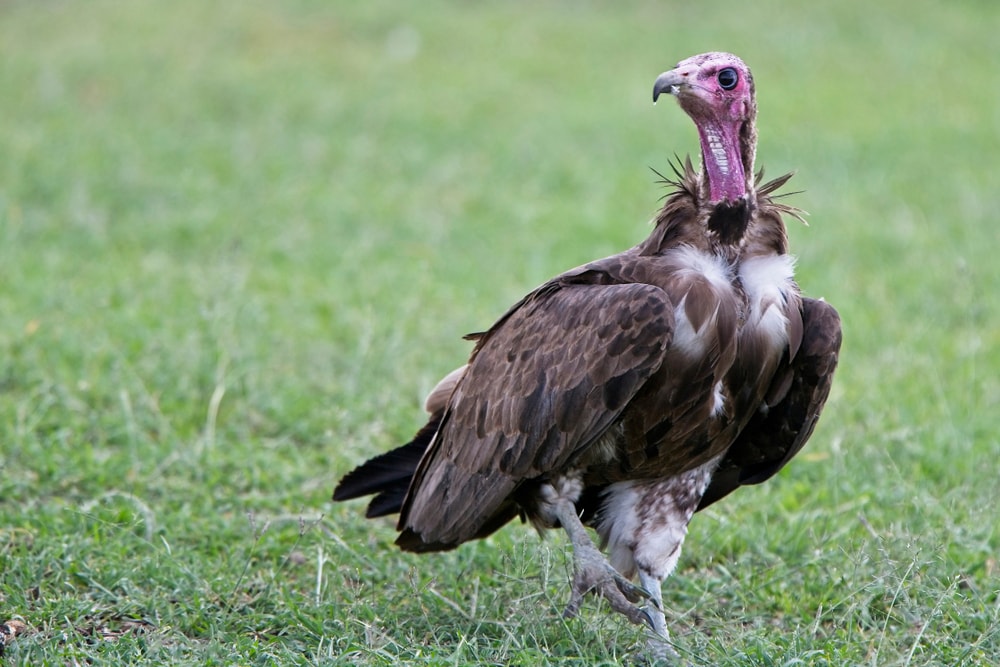
Lappet-faced vultures are endemic to Africa and Western Asia. They are the largest vultures in Africa, weighing up to 20 lbs (9.4 kg). They can also live up to 50 years in the wild. Lappet-faced vultures get their name from the flaps of skin, called lappets, on the sides of their neck.
Their large size makes lappet-faced vultures powerful birds. They are known to be aggressive towards other vultures while feeding. They’ve even been known to chase away jackals and other large predators from feeding sites.
Their strong beaks are adept at tearing into a dead animal’s flesh, tendons, and muscles. They’re usually the first to feed on fresh carrion because their beaks can easily cut through the tough skin.
Like white-headed vultures, nests of lappet-faced vultures are sometimes built in baobab trees. Usually, only one egg is laid, and the male and female take turns incubating and scavenging.
Once the chick hatches, the parents feed it regurgitated food directly into its mouth. Chicks are small and vulnerable at birth. However, if food is plentiful, they can double in size within the first week of their life.
As the chick grows, parents will begin feeding it chunks of meat instead of homemade stomach soup. Fledglings take flight at around three months old and usually leave the nest after four months.
Young lappet-faced vultures have a rough go of it at first. They can barely compete with larger vultures and animals for food.
But with perseverance, they snatch bits of food when they can and continue to grow until they become kings and queens on the proverbial carrion hill.
Red-Headed Vulture (Sarcogyps calvus)
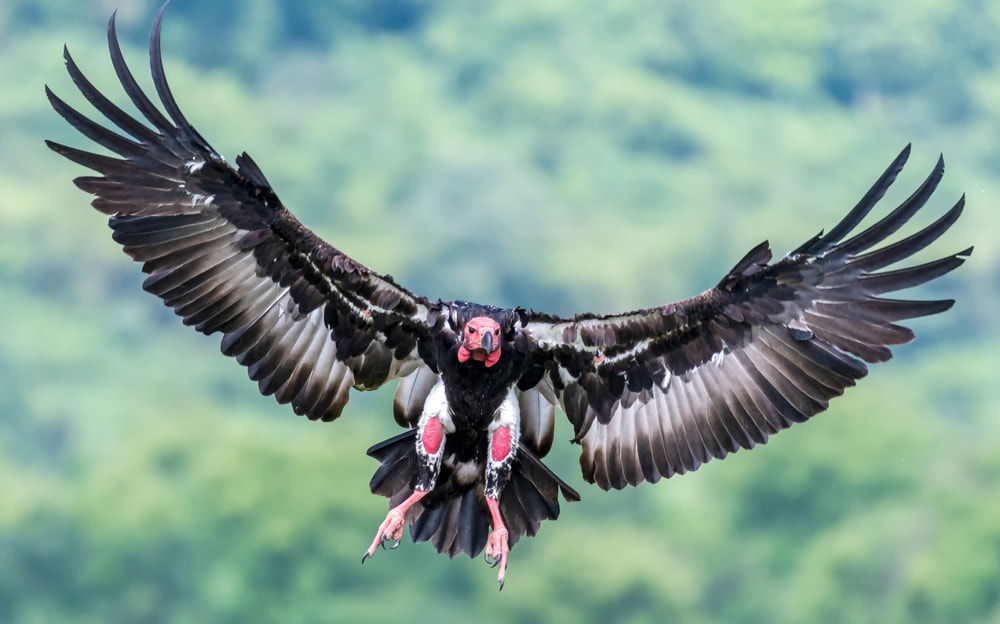
The red-headed vulture ranges from the Middle East to Malaysia. Their wingspan reaches an impressive 8 or 9 feet (2 or 3 meters).
As you might have guessed, red-headed vultures have bald, red heads. The word Calvus in their scientific name is Latin for “bald.”
In addition to their red heads, their body is covered in black feathers, with some patches of white on their undersides.
Red-headed vultures, like all vultures, have wide wingspans, which aid them in riding warm air currents known as thermals. Thermals spiral upwards from the ground, and vultures ride the current as it lifts them high into the air.
Vultures’ thermal-riding ability means they don’t have to exhaust themselves by constantly flapping their wings to stay aloft. Instead, they can survey the land for carrion while conserving their energy.
So, contrary to popular belief, circling vultures don’t always indicate a fresh animal carcass.
Unfortunately, the red-headed vultures’ population has declined due to diclofenac use within their native range. Diclofenac is a medicine that farmers give to sick livestock. When the diclofenac-treated animal dies, their meat is tainted with the drug. The drug can be fatal if ingested by red-headed vultures.
Some surveys suggest a tragic 90% decline in red-headed vulture populations beginning in the 2000s.
Hooded Vulture (Necrosyrtes monachus)
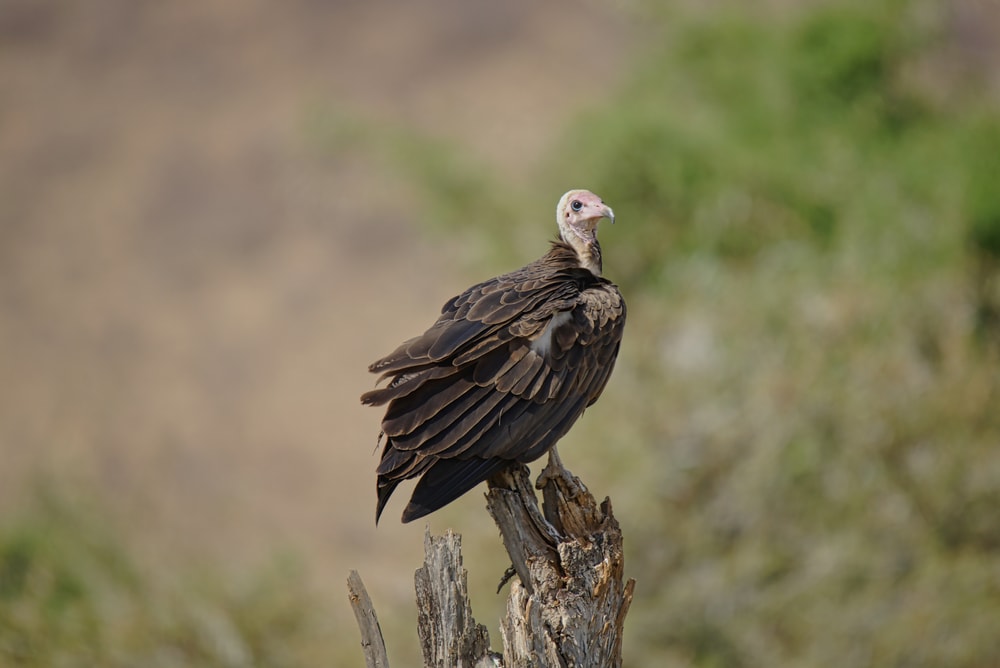
The hooded vulture is one of the gnarliest vultures on our list. Its Greek scientific name roughly translates to “hooded corpse-dragger” or “corpse-dragging monk.” Talk about morbid.
Hooded vultures are native to parts of central and southern Africa. They are one of the smallest Old World vultures, weighing only 5 lbs (2.6 kg) and having a wingspan of 5 feet (1.5 m). They get their name from the distinct “hood” of feathers on the back of their necks.
Like all vultures, hooded vultures usually dine on carrion. However, coastal hooded vultures also crave seafood and scour the coast for shellfish or dead fish.
Hooded vultures also stick close to other scavenging animals, like hyenas or wild dogs, to help them find food.
Unlike many species of vultures, the hooded vulture is a little socialite. They form “colonies,” groups ranging between 50 to 250 individuals.
Following the apparent theme for this list, the hooded vulture is considered critically endangered. As with other endangered vultures, this is primarily due to unintentional poisoning by farming chemicals.
Cape Vulture (Gyps coprotheres)
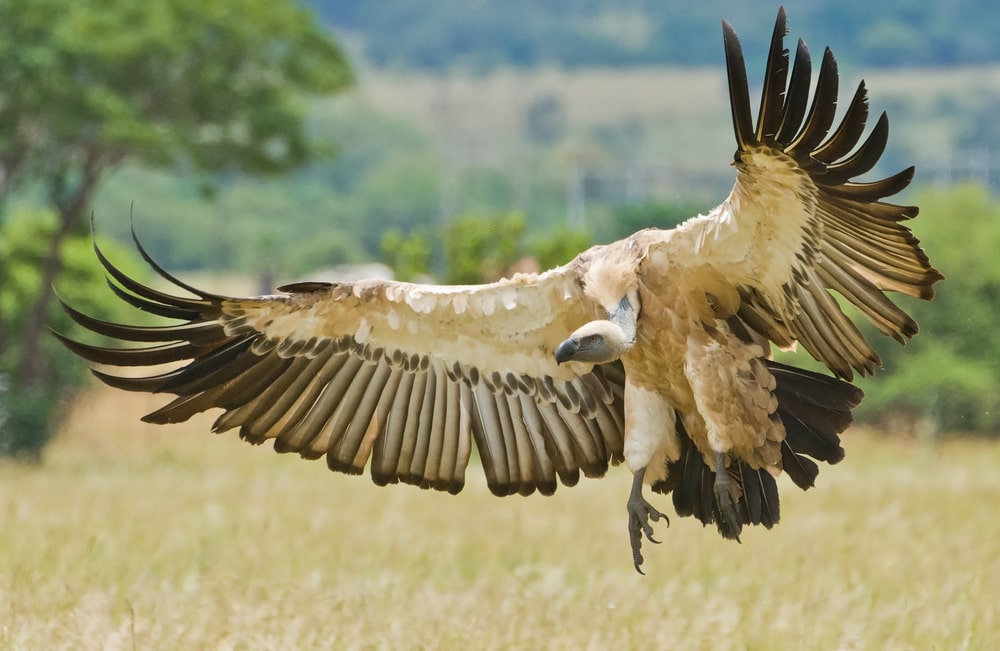
The cape vulture is endemic to southern Africa. Its wingspan is around 8 feet (2.6 m). Cape vultures are whitish-brown with darker feathers on the undersides of their wings and tail. They also have bare patches on the top of their chest, right below their neck. This supposedly helps them detect thermals.
Like the hooded vultures, cape vultures sometimes form small colonies. They mainly roost and nest in the hills and mountains of southern Africa but fly hundreds of miles in search of food.
Cape vultures have serrated tongues. It is used to access hard-to-reach areas of soft flesh or marrow inaccessible to other scavengers.
They can also fill their stomach within five minutes, meaning they can avoid confrontation with other scavengers by quickly snatching up a full meal.
Unfortunately, as with other vultures on this list, cape vultures are endangered, and populations continue to decline.
White-backed Vultures (Gyps africanus)
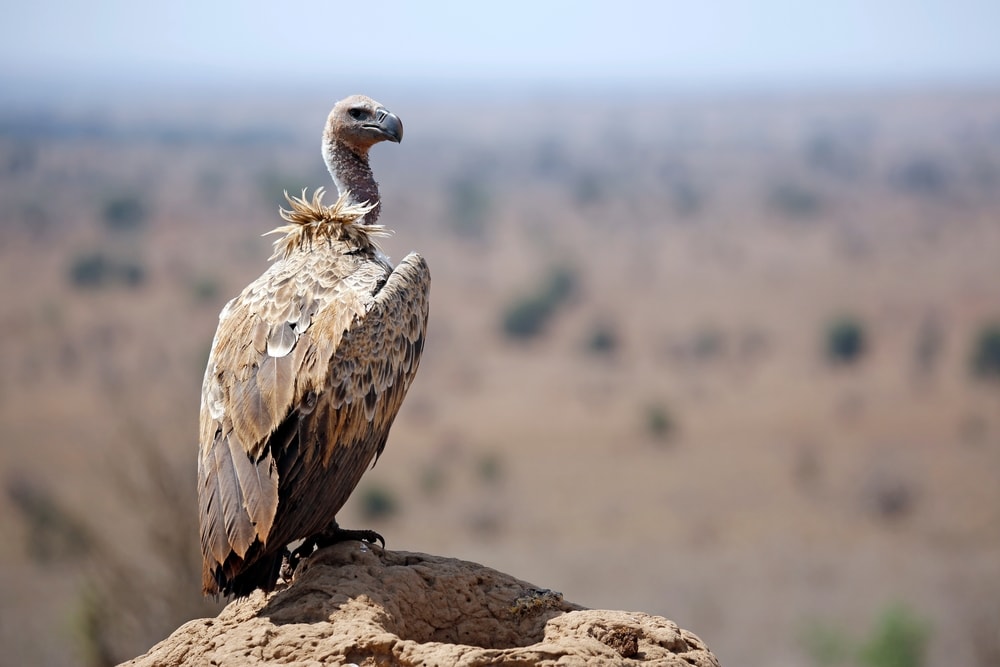
White-backed vultures live in sub-Saharan Africa and are the most common vulture in the region. They look similar to cape vultures but are much smaller. Wingspans average around 7.5 feet (2.2 m).
White-backed vultures are social and will signal other vultures to join in on the feast. When approaching a carcass, the usually silent vultures will make pig-like squeals, perhaps out of excitement. Occasionally, a large group of white-backed vultures can pick a carcass clean in under 5 minutes!
These scavengers don’t shy away from human settlements either. Some vultures venture into towns searching for dead livestock or other potential meals.
Like other Old World vultures, the white-backed vulture is endangered due to unintentional poisoning.
Not only that, but poaching for meat and use in traditional medicine is also harming white-backed vulture populations. Studies suggest that these practices will lead to local extinction in some areas.
The once-widespread vulture is estimated to have only 270,000 individuals left in the wild.
Himalayan Vulture (Gyps himalayensis)
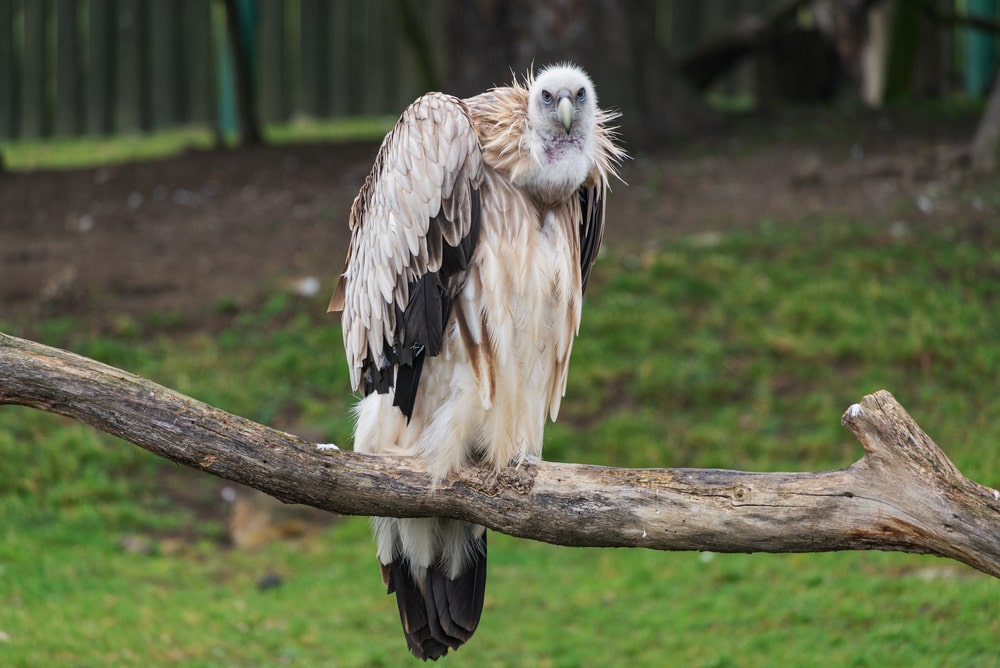
The Himalayan vulture is the mountaineer of the vulture world. They live in the frigid heights of the Himalayas and the surrounding Tibetan plateau. They can live at elevations up to 18,000 feet (5,500 m), braving the cold and low air pressure of high altitudes.
For perspective, Mount Everest has an elevation of 29,035 feet (8,850 m). That means Himalayan vultures live just over 11,000 feet (3,352.8 m) away from the world’s highest summit.
Himalayan vultures are the second largest Old World vultures. They have a wingspan of over 9 feet (2.7 m) and weigh over 26 lbs (12 kg).
Their feathers are brown with some light patches. Notably, their heads are covered with downy feathers.
Preferring solitude, Himalayan vultures don’t form flocks. They usually nest high above the treeline on rocky cliffs but will migrate to foothills and plains in search of food. They avoid human settlements but have the unnerving habit of following caravans of livestock passing through the mountains.
Being so large, the Himalayan vulture has little competition with other animals when scavenging for food.
Like the red-headed vulture and many other vultures on this list, Himalayan vulture populations have declined because of the use of diclofenac. Luckily, populations seem stable now.
However, they are still considered near threatened by the International Union for Conservation of Nature (IUCN)
Slender-Billed Vulture (Gyps tenuirostris)
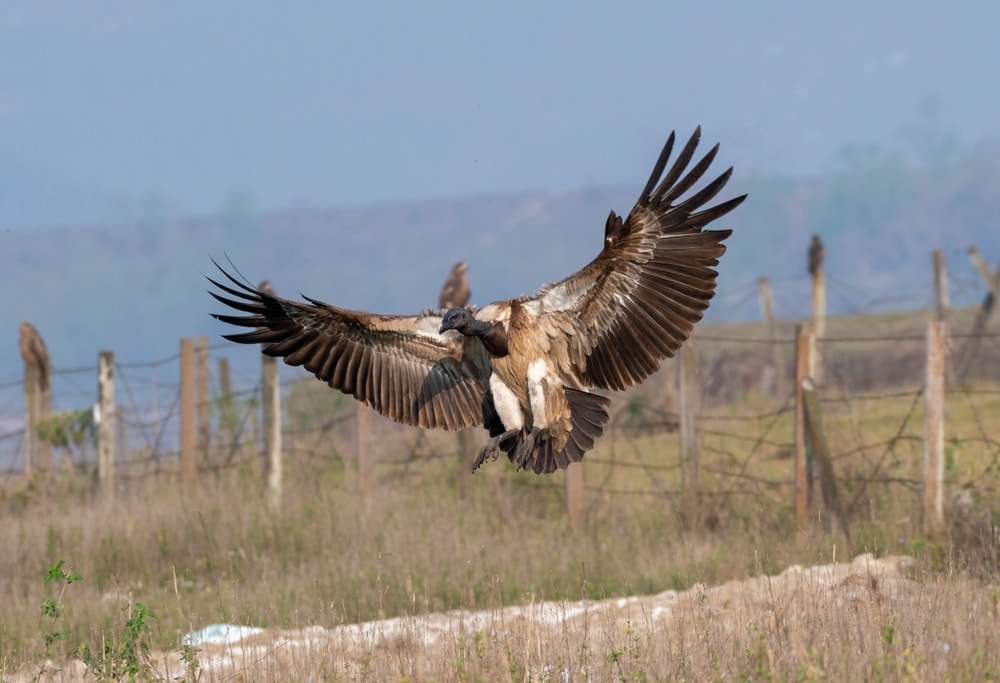
Ah, yes, yet another vulture with a hyphenated name. The slender-billed vulture is native to the sub-Himalayan parts of Southeast Asia.
They’re medium-sized vultures with brown feathers, white or cream undersides, and long, dark necks and heads. Their beaks are long with hooked tips.
Slender-billed vultures have also been severely impacted by diclofenac use. Populations have declined by 97% since the early 2000s. Cambodia is home to the last wild breeding population of slender-billed vultures.
In 2009, they were estimated to be completely extinct in the wild within the next decade. While not yet wholly extinct, fewer than 800 individuals are thought to remain as of 2021.
Indian Vulture (Gyps indicus)
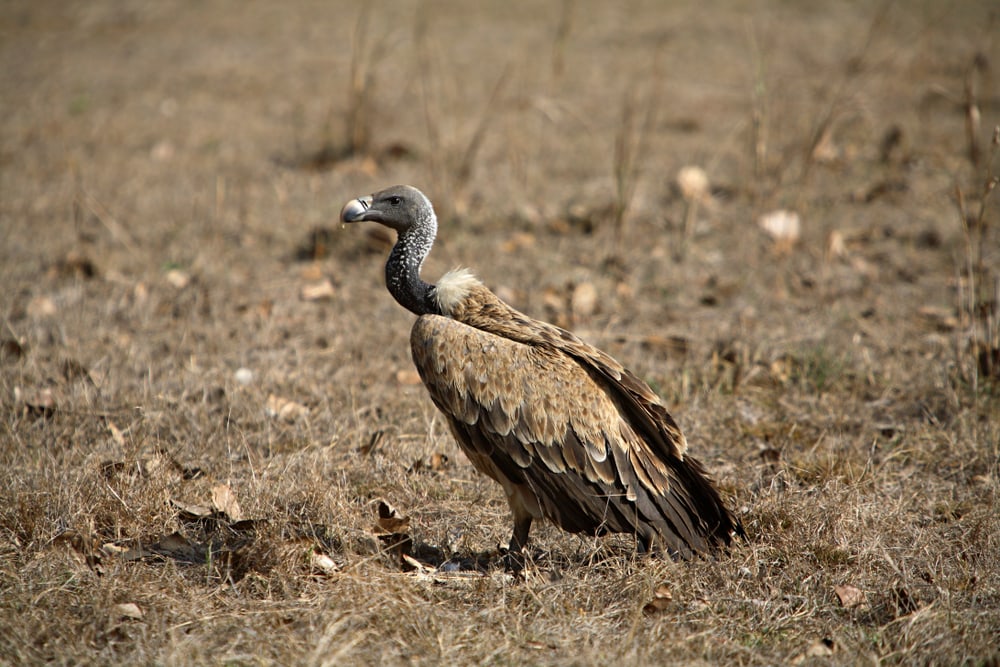
Indian vultures are native to India, Pakistan, and parts of Nepal. They look a lot like the slender-billed vulture. At one time, the two were considered the same species.
Indian vultures are social birds and often gather in flocks, especially during feeding. They will travel over 60 miles (100 km) daily in search of food.
Once again, Indian vultures have been hit hard by diclofenac use. For perspective, the combined population of Indian, slender-billed, and white-rumped vultures was over 40 million in the 1980s. In 2017, the combined population was 19,000. South Asia has lost 99% of its vulture population in four decades.
In what has been called the “Indian Vulture Crisis,” the loss of so many vultures is the fastest decline of any known animal population in the world.
In India, the loss of the Indian vulture has serious ecological consequences.
Think of vultures as nature’s trash collectors. Without them, trash (or, in this case, carrion) piles up, increasing the risk of infectious diseases, unsanitary conditions, and damage to the soil.
Another significant consequence in India is increased feral dog populations. Feral dogs can sustain themselves by eating carrion, usually reserved for the vultures. However, wild dogs spread diseases instead of eliminating infectious diseases as vultures do.
The loss of Indian vultures is beginning to form a public health crisis. Fortunately, efforts have been made to stabilize the vulture population and ensure survival.
Ruppell’s Vulture (Gyps rueppelli)
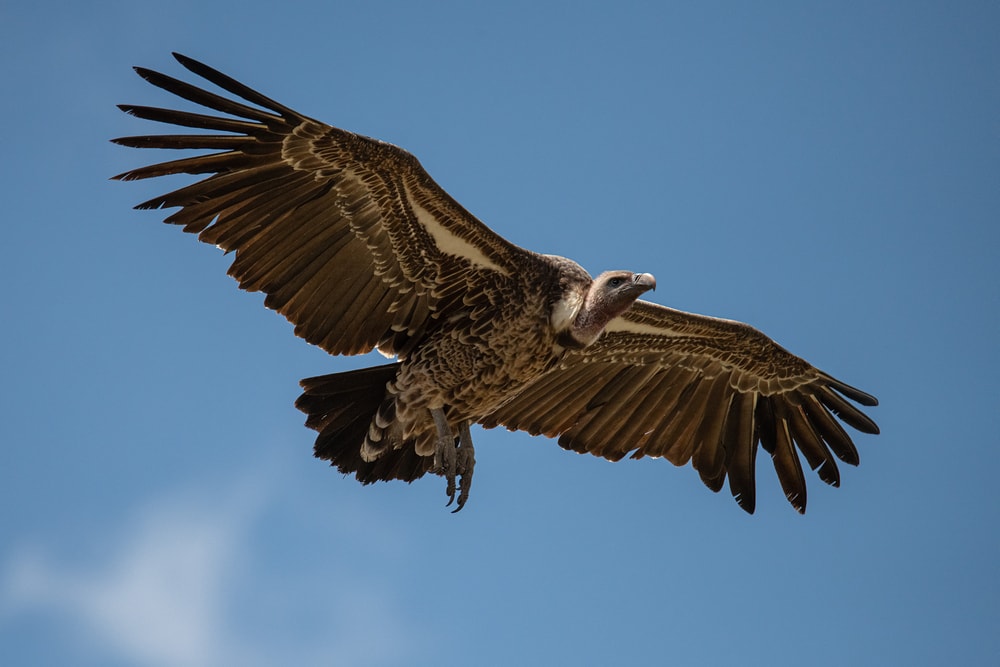
Ruppell’s vulture lives in Western Africa. They are relatively large, with wingspans stretching up to 8 feet (2.5 m). Like the Himalayan vulture, Ruppell’s vultures have downy feathers covering their necks and faces.
These vultures are the highest-flying birds on the planet. They can soar up to 36,000 feet (10,973 m) above sea level. That’s about as high as most airplanes fly! Ruppell’s vultures have unique proteins that allow them to withstand high altitudes with minimal oxygen.
Ruppell’s vultures are highly social and gather in flocks that can number in the thousands. They can also live up to 50 years in the wild.
Like the other vultures on this list so far, Ruppell’s vultures are critically endangered. This has to do with a combination of poisoning, habitat loss, and overhunting for food and medicine.
The use of vultures in medicine is quite interesting. In African cultures, vultures are believed to be clairvoyant or able to see into the future. They’re used in medicine and magic supposedly to increase intelligence or make the consumer clairvoyant as well.
As with other vultures, poisoning is the number one threat. In one study, ten poisoned carcasses were responsible for the deaths of 37 to 600 vultures each.
White-Rumped Vulture (Gyps bengalensis)
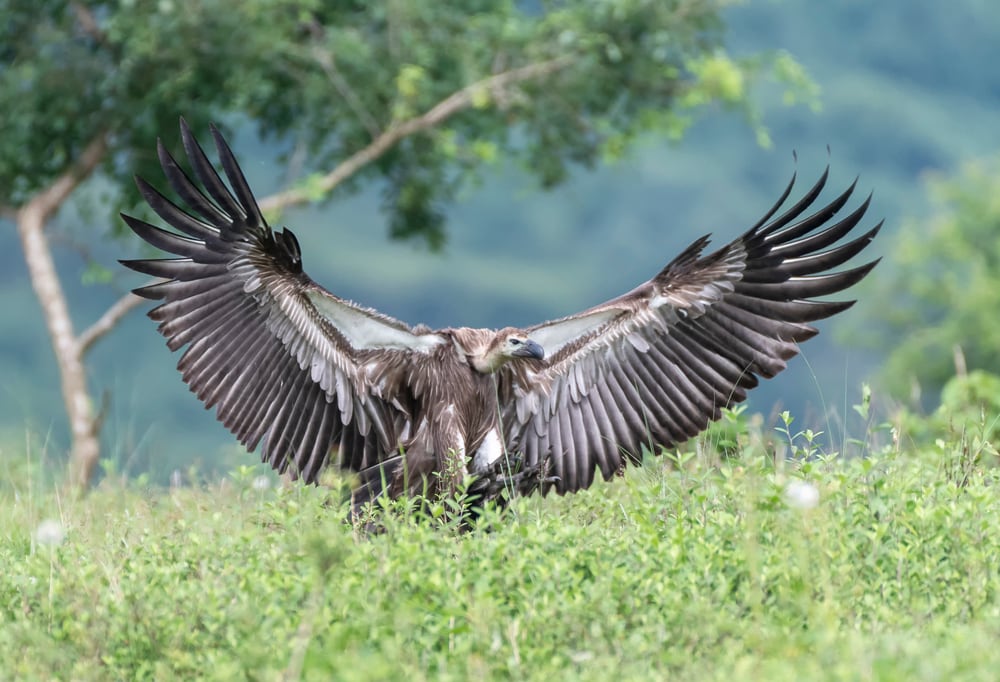
Once believed to be the world’s most abundant bird of prey, white-rumped vulture populations have been in steep decline. In the 1980s, their population numbered in the millions. As of 2021, populations have declined to a meager 6,000.
Native to South and Southeast Asia, white-rumped vultures are social creatures. They gather in flocks to eat together and often nest together as well. These vultures often compete with red-headed vultures.
Red-headed vultures have even been known to chase white-rumped vultures from their nests.
An interesting habit of the white-rumped vulture is that they sometimes swallow the bones of dead animals along with the meat. They also like to stay clean; if water is available, they will take frequent baths.
Griffon Vulture (Gyps fulvus)
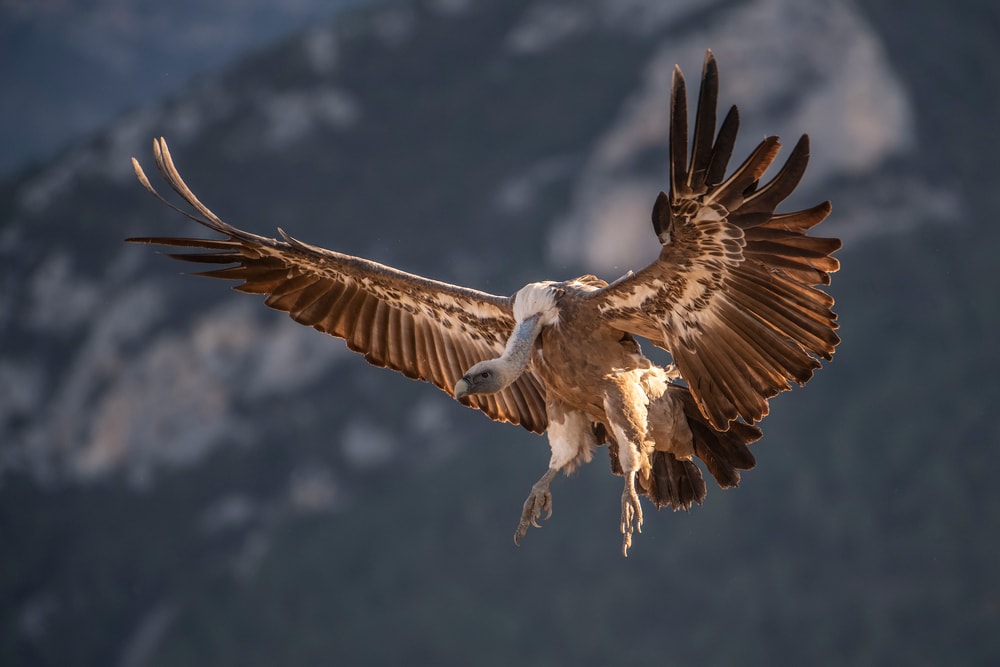
The griffon vulture is native to Eurasia, ranging from India to Spain. Quite large, these vultures have brown and white feathers and wingspans up to 9 feet (2.8 m).
Griffon vultures are highly efficient energy savers. Griffon vultures soar using a fraction of the energy most other birds use. They can even return to a resting heart rate mere minutes after taking off from the ground.
Fortunately, griffin vultures are listed as “least concern” by the IUCN. Populations began to decline in the 20th century but have since stabilized. Some populations have even increased in recent years, especially in their western range.
Cinereous Vulture (Aegypius monachus)
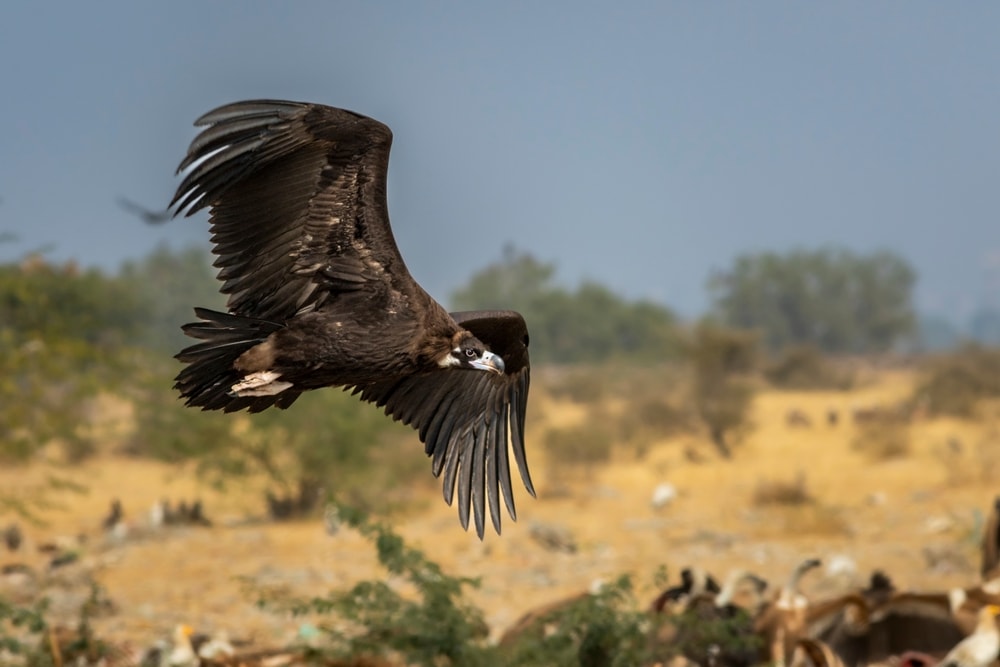
Cinereous vultures are the largest species of Old World vultures. They can reach lengths of over 4 feet (1.2m) and have a wingspan of up to 10 feet (3 m).
These large birds usually have brown feathers, despite the word “cinereous,” meaning “ash gray.” They also have hoodlike feathers stretching up their necks and heads, giving them the nickname “monk vulture.”
Believe it or not, cinereous vultures are important in certain human funerary rights. In Mongolia, for example, the rocky ground makes it hard to bury the dead. So instead, corpses are laid out in the open where vultures can feed on them.
The vultures are considered sacred and are believed to carry the soul of the deceased person up into the afterlife.
Egyptian Vulture (Neophron percnopterus)
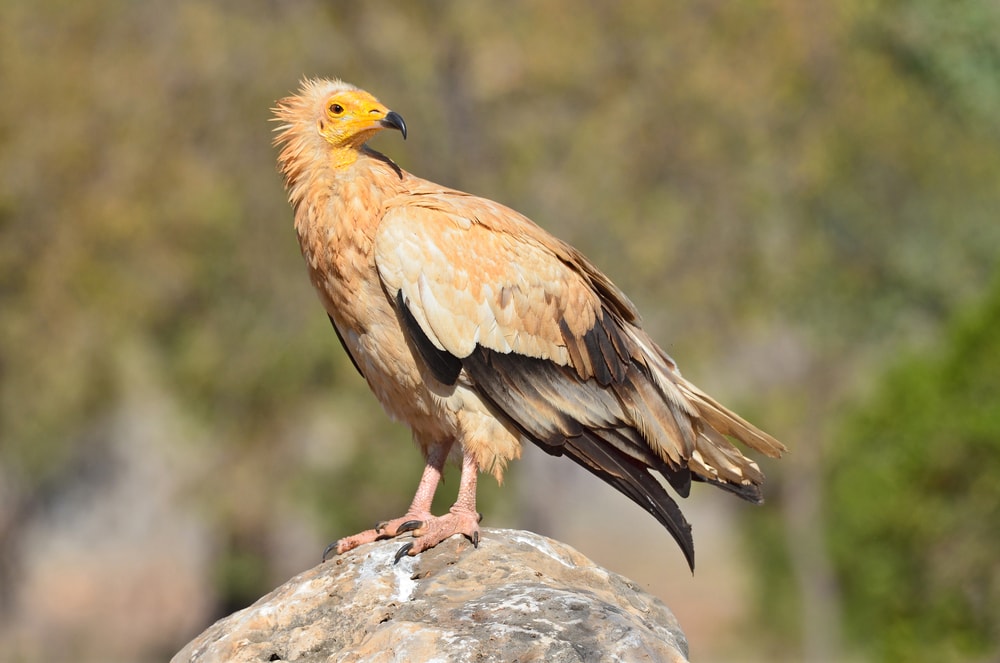
The Egyptian vulture looks quite different compared to other vultures. They are primarily white with orange beaks. Because of this, they are sometimes known as “white scavengers.”
Egyptian vultures are found outside of Egypt. Their range extends from Spain across North Africa and into India.
They have an interesting scientific name, too. Neophron refers to a Greek mythological figure who was turned into a vulture by Zeus. The word translates to something like “foolish” or “foolish mind.”
Percnopterus is a combination of Greek words meaning “dark-winged.” This refers to the Egyptian vulture’s dark underwings.
Despite Neophron being in their name, Egyptian vultures are anything but fools. They are the only vulture known to use tools. They pick up heavy rocks and use them to crack bones or unguarded ostrich eggs.
Palm-Nut Vulture (Gypohierax angolensis)
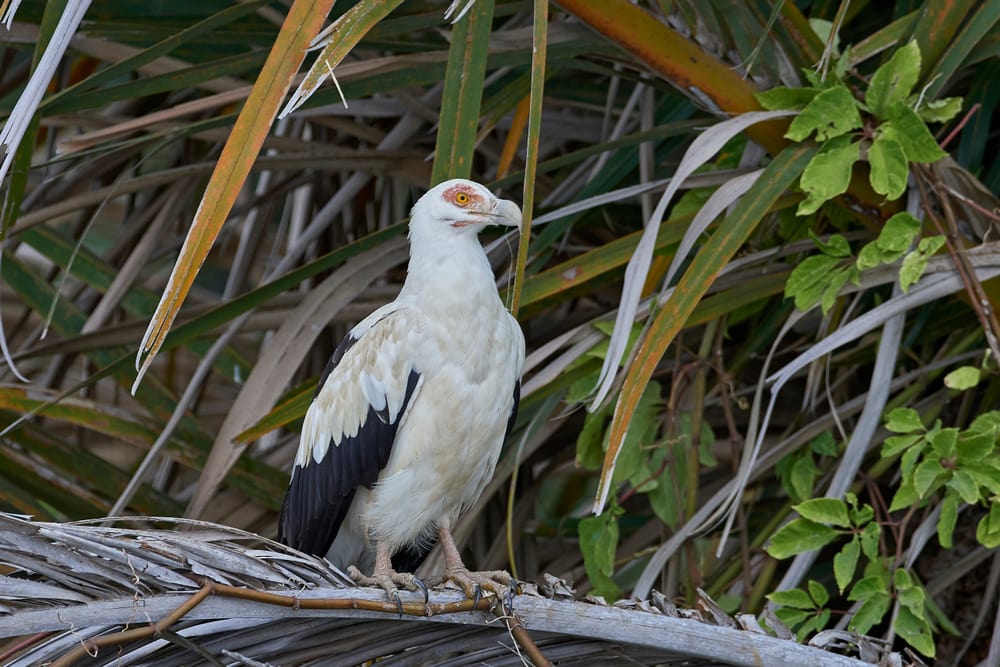
Palm-nut vultures are found in the coastal regions of Africa. They have black and white feathers with orange-red faces.
Palm-nut vultures have special diets that are around 65% fruit based. They feed on various fruits, including dates and – you guessed it–palm nuts. Sometimes, palm-nut vultures will hang upside-down from palm nuts (which grow in large bunches) and feed on them that way.
Aside from fruit and carrion, they also hunt for crabs, fish, and small reptiles.
Palm-nut vultures are aerial acrobats. During mating displays, a male and female will soar together and perform a variety of rolls and dives. Like most vultures, only one egg is laid by a mated pair.
Thankfully, due to their diverse diet, palm-nut vultures have not been as affected by diclofenac poisoning.
The IUCN labels them as a species of “least concern.” However, some populations have been affected by habitat loss, especially in South Africa.
Bearded Vulture (Gypaetus barbatus)
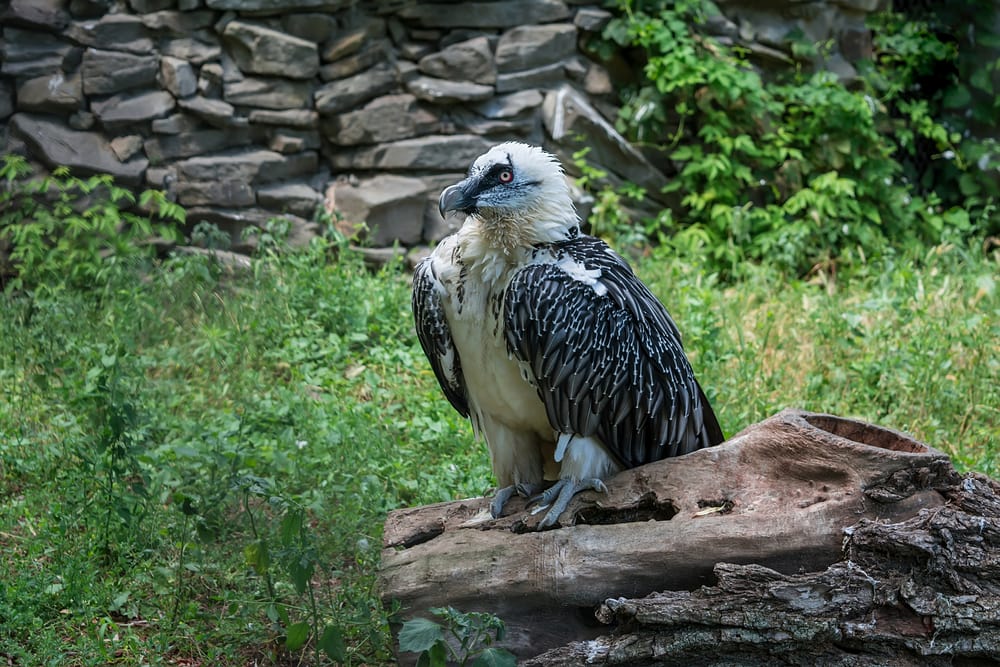
Bearded vultures are, to be frank, awesome looking. They have golden-brown coats, dark wings, blueish faces, and long, bristly feathers that stretch from their eyelids to their chin (hence the name).
Residents of the Alpine regions of Europe and mountain regions of Africa and the Middle East, bearded vultures are high-altitude birds.
They are monogamous, and mated pairs defend a territory that can range up to 250 miles (400 km).
Bearded vultures feed almost only on bone. They throw large bones off cliffs to shatter them and make them easier to eat. Their strong stomach acids have no trouble breaking down the bone and fully digesting them.
Bearded vultures were once believed to attack lambs and even young children. People subsequently hunted them to near extinction, and now only 100 mating pairs remain in the wild.
New World Vultures
Black Vulture (Coragyps atratus)
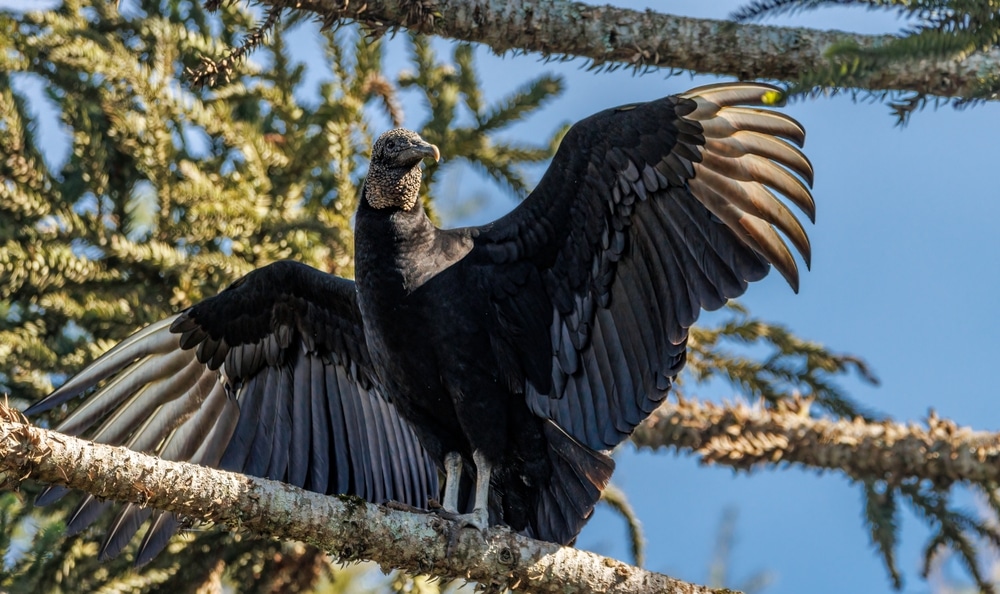
Also known as the American black vulture and Mexican vulture, black vultures range from the northeastern US to South America. They are, as the name implies, all black. However, some of their flight feathers are a lighter, slate color.
Black vultures are pretty common throughout their range. However, populations in the southeast United States have declined, likely due to habitat loss.
In addition, black vultures are fond of nesting in tree hollows, so deforestation stresses nesting site availability.
Black vultures are social birds and often gather in flocks when feeding and soaring. Black vultures can be aggressive toward other birds.
Despite being similar in size, black vultures will chase away turkey vultures from feeding sites. The black vulture’s case is more about intimidation and aggression than size and strength.
Occasionally you can see black vultures standing or perching with their wings spread out. This stance is called the “horaltic pose.” It increases bodily surface area and helps them warm up in the mornings or after rain.
However, it’s a daunting pose, making the vultures look like black crosses stuck on trees or rooftops.
Black vultures have relatively short wingspans when compared to other vultures. Their wingspans average around 5 feet (1.2 m), making them less efficient fliers than other vulture species.
They also have the uncanny habit of throwing up food when approached or disturbed. This is supposedly to help deter/distract predators.
Turkey Vulture (Cathartes aura)
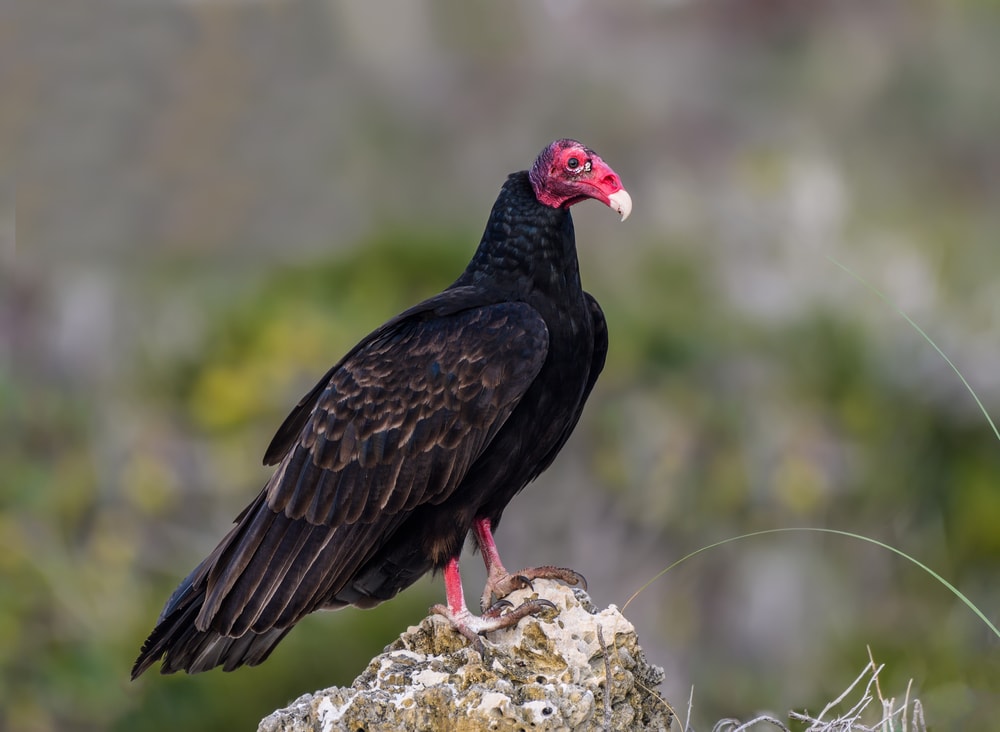
Common throughout much of North America and South America, turkey vultures stand out because of their bright red heads. They are similar in size to black vultures. They have dark brown feathers with lighter colors on their undersides.
Turkey vultures have incredible senses of sight and smell. They often fly lower than other vultures and can pinpoint carrion by scent alone. In fact, they can smell carrion from over a mile away.
Like the black vulture, turkey vultures are social and are often seen in flocks or pairs. Sometimes, they can even be seen roosting with black vultures.
Interestingly, the scientific name of turkey vultures means “cleansing breeze.” That’s quite a contrast to the “corpse-dragging monk” name given to hooded vultures!
Turkey vultures live up to 20 years in the wild. Unlike the black vulture, turkey vultures are efficient fliers and have been known to travel up to 200 miles (322 km) daily.
Lesser Yellow-Headed Vulture (Cathartes burrovianus)
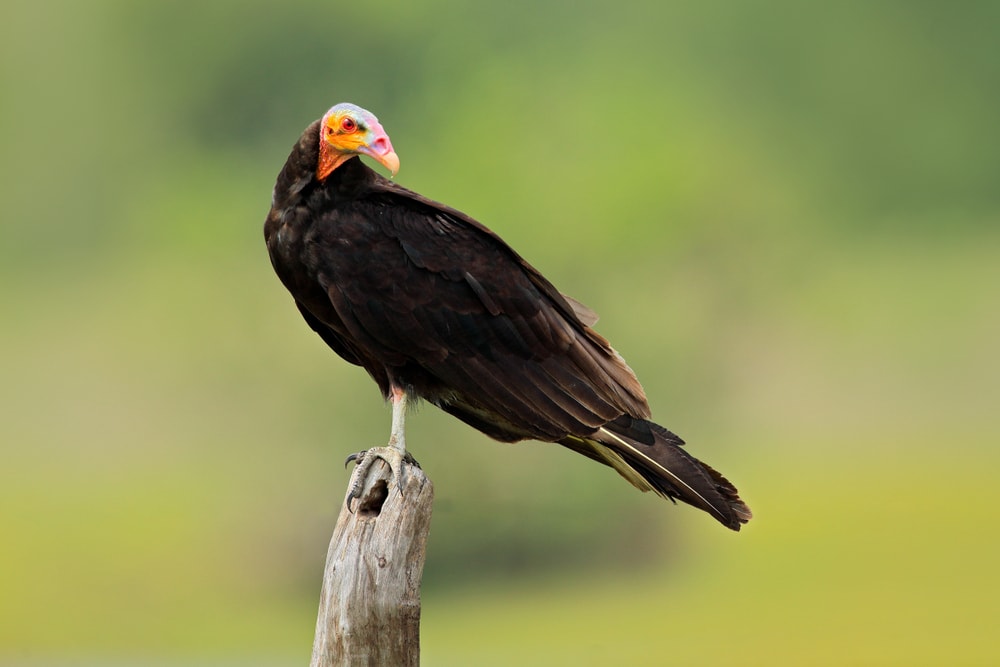
Natives of South and Central America, the yellow-headed vulture is similar to the turkey vulture in size. They have dark brown or black feathers, grayish legs and feet, and bright yellow heads.
Unlike other vultures, the lesser yellow-headed vulture has a weak beak. Therefore, they must rely on larger vultures, like the king vulture, to rip into the hides of animal carcasses for them.
Lesser yellow-headed vultures also don’t build nests. Instead, they prefer laying eggs on the ground, in tree hollows, caves, or cliff edges.
Usually, two eggs are laid, and chicks fledge (develop flight feathers ) after around three months.
The IUCN lists lesser yellow-headed vultures as a species of least concern. Populations are stable and there are no significant threats against them.
However, many lesser yellow-heads rely on wetlands for survival. These wetlands are being altered by climate change and human encroachment, which has resulted in some vulture populations needing to migrate.
Greater Yellow-Headed Vulture (Cathartes melambrotus)
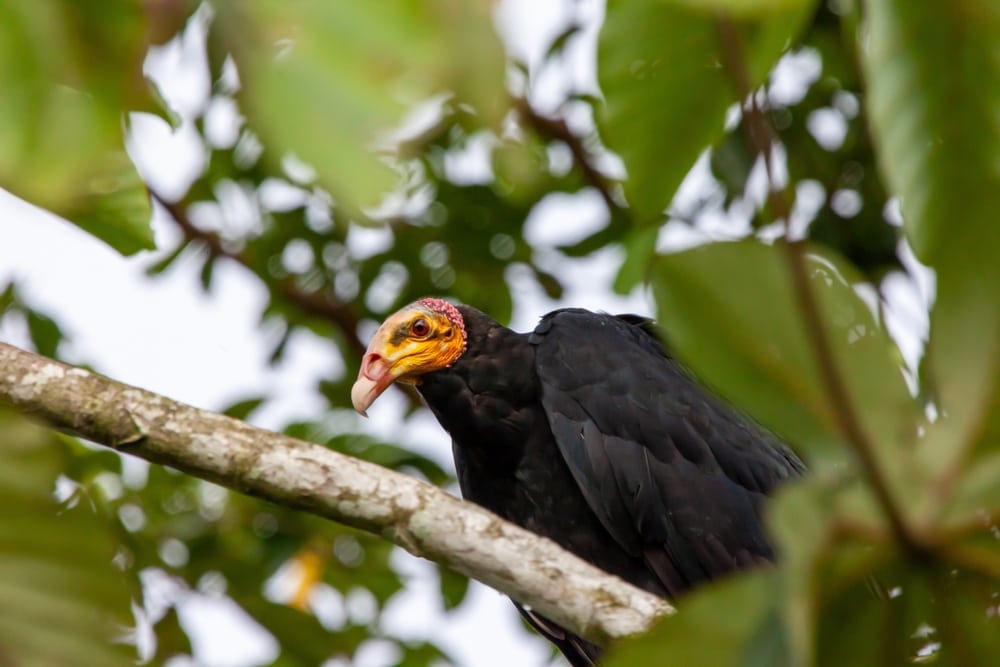
Once thought to be the same species as the lesser yellow-headed vulture, the greater yellow-head is found throughout northern South America.
These vultures are slightly larger than the lesser yellow-heads. They also prefer solitude, although they occasionally roost and soar in pairs.
Greater yellow-heads have an excellent sense of smell which they use to find potential meals. King vultures, which lack a good sense of smell, will sometimes follow yellow-heads to feeding sights.
In return for leading them to carrion, king vultures will open up the animal carcass for the weak-beaked yellow-head that can’t always do so.
Like the lesser yellow-head, the greater yellow-headed vulture is a species of least concern as listed by the IUCN. While an exact population count is unknown, some estimates number them in the millions.
California Condor (Gymnogyps californianus)
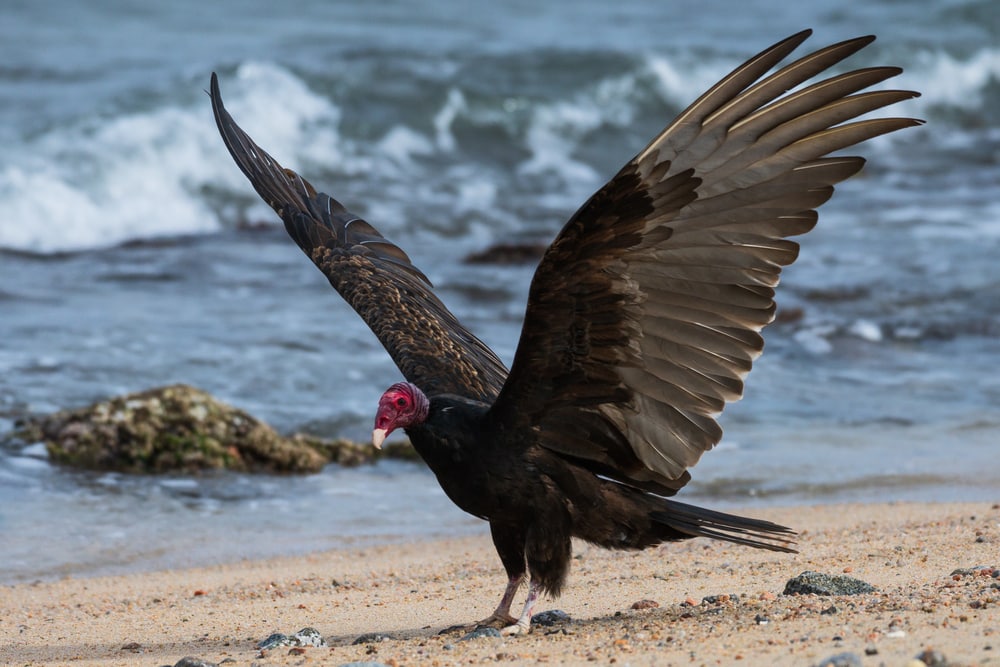
The California condor is native to the western United States. They are massive birds weighing up to 30 lbs (13.6 kg) with a wingspan of over 10 feet (3 m). They have black feathers, white underwings, and yellowish heads.
California condors once had a prehistoric range that stretched to the eastern United States. Condor populations began to decline when European settlers arrived in the Americas.
Lead poisoning devastated condor populations, as condors would accidentally ingest lead bullets from animals killed with guns.
California condors were incredibly close to becoming extinct in the latter half of the 20th century. In fact, they were completely extinct in the wild. However, captive breeding initiatives began with hopes of reintroducing them into the wild.
The programs were major successes. For example, in 1987, only 27 condors remained in the world. By 2022, condor populations have risen to over 500 individuals and are continuing to grow.
Andean Condor (Vultur gryphus)
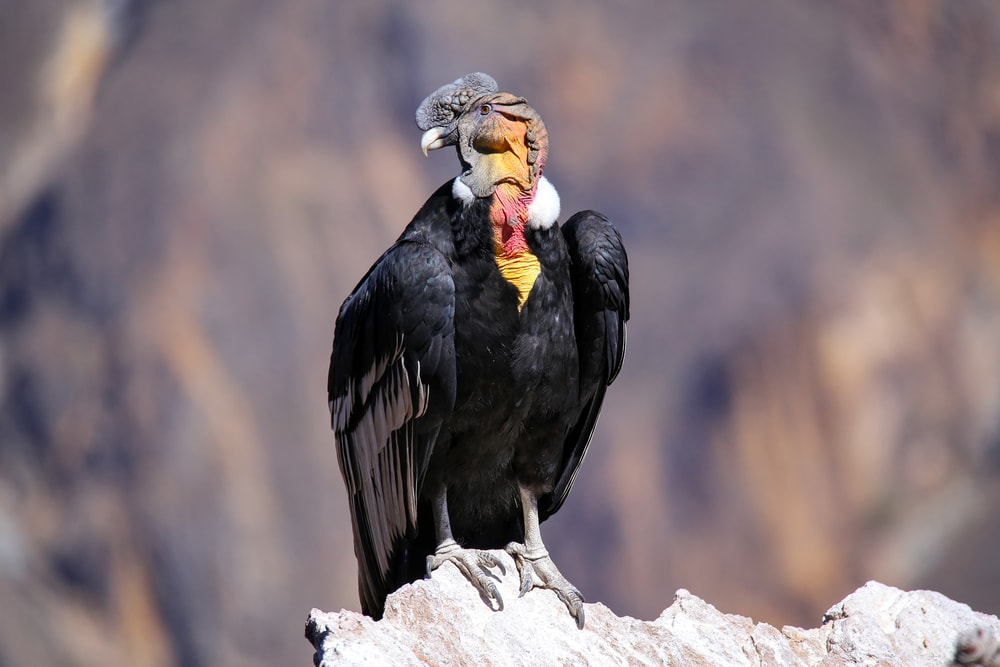
Native to the Andes mountain range of South America, the Andean condor is large with black and white feathers, red or yellow eyes, and dark red or black heads. They are slightly larger than California condors, with wingspans averaging around 10.5 feet (3.2 m).
Andean condors are the only sexually dimorphic vultures, meaning females and males have different appearances.
For example, females have bright red eyes while males don’t. Conversely, males have large “combs” on their heads that are absent in females.
Andean condors prefer nesting high up in the cliffs of the Andes. They can soar as high as 18,000 feet (5,5000 meters) and occasionally fly down to the lowlands in search of food.
When Andean condors find food, they gorge themselves and eat up to 15 lbs (6.8 kg), after which they may be unable to fly.
Like the California condor, Andean condors were nearing extinction in the 20th century. Luckily, captive breeding programs were created to reintroduce Andean condors to the wild. Today, numbers are increasing, with their population estimated to be around 10,000 individuals.
King Vulture (Sarcoramphus papa)
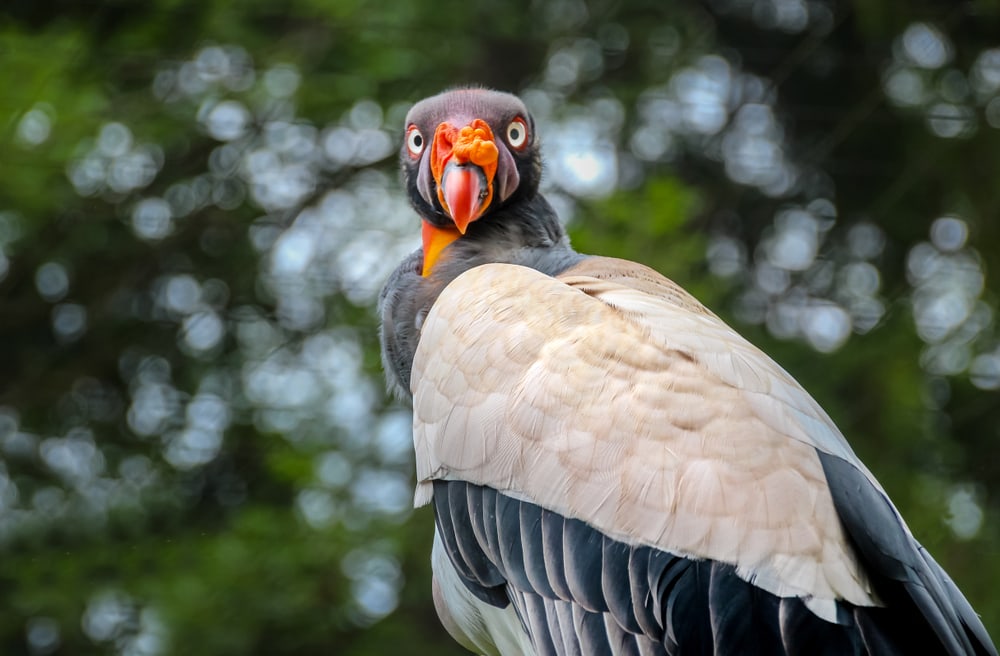
King vultures are native to Central and South America. They are primarily white with black wings and multicolored heads. King vultures are the largest New World vultures aside from both condor species.
The king vulture gets its name because other birds make way for the king vulture at feeding sites. In other words, king vultures are treated like royalty in the bird world.
As previously mentioned, king vultures have a poor sense of smell and must rely on other vultures to locate food.
They are not social birds, but they tolerate the presence of other vultures at feeding sites. They are also known to form small family units, which they may roost or travel with.
King vultures can live up to 40 years in the wild. Females reach maturity at five years old, and males mature at around seven. They are monogamous and will stay with their mate for their life.
King vultures are not considered endangered. But, populations have declined in recent years due to deforestation and habitat loss.
You May Also Like: The 9 Different Types Of Hawks In Michigan (ID Guide, Pics And Facts)
The Peregrine Fund
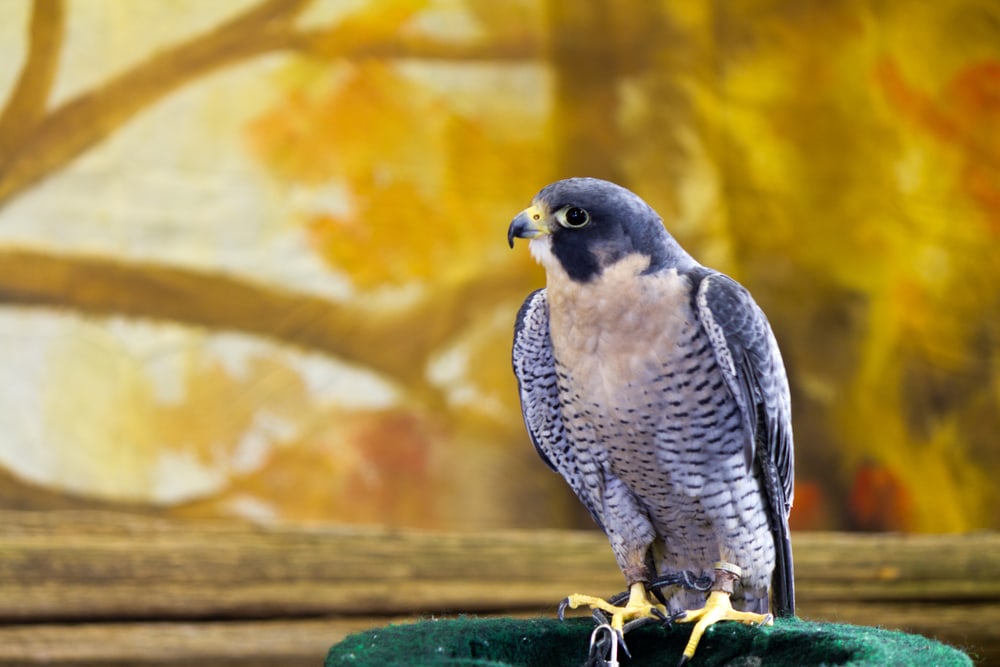
As you may have noticed, most of the vultures on this list are endangered or have declining populations. Vultures fill an important ecological niche. Without their help as nature’s clean-up crew, entire ecosystems could be thrown off balance.
Thankfully, some foundations have been started to help endangered vultures and other birds worldwide.
One such organization is the Peregrine Fund. If you’d like to learn more about what is being done to save the vultures, check out their website at the link below.
The Peregrine Fund: Home | The Peregrine Fund
You May Also Like: The 13 Species of Hawks in Florida (Chart and Pictures)
Types of Vultures FAQ
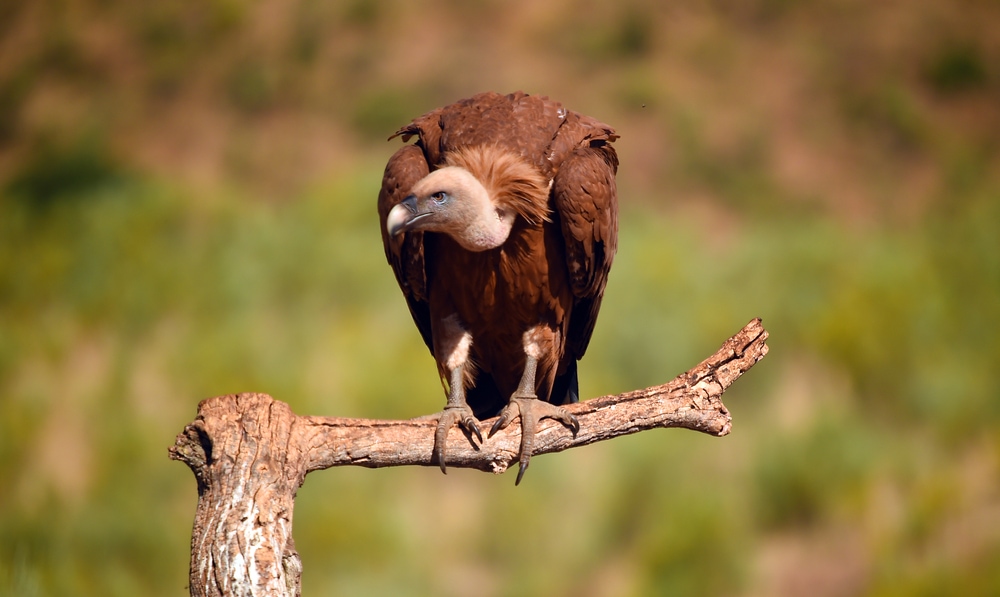
Do vultures eat live animals?
Very rarely. Vultures primarily feed on carrion, like roadkill, for example. However, vultures like the palm-nut vulture have a partly fruit-based diet.
Other vultures, like the hooded vulture, sometimes eat crabs and shellfish too. So there are exceptions to every rule.
Are buzzards and vultures the same?
Yes and no. In the United States, the terms buzzard and vulture are used interchangeably to describe the same bird. In other places a distinction is made.
Real buzzards are distinct from vultures and belong to the genus Buteo. This genus includes hawks, like the American red-tailed hawk (Buteo jamaicensis), for example.
Which is stronger, an eagle or a vulture?
It depends on what species you are comparing. However, some vultures, especially the condors, tend to be larger than eagles. This doesn’t necessarily mean they’re stronger, but a vulture could definitely put up a fight against an eagle.
Which US state has the most vultures?
It’s not known which US state has the most vultures. However, turkey vultures are the most widespread vultures in the Americas. So, even if a state has few resident vultures, some of them are going to be turkey vultures.
Which country has the most vultures?
Once again, it’s not known exactly which country has the most vultures. However, diclofenac isn’t a problem for New World vultures. So, it may be safe to assume that the Americas support the highest vulture populations.
You may also like:
Want to learn more about types of vultures and elsewhere? Check out the articles below!









